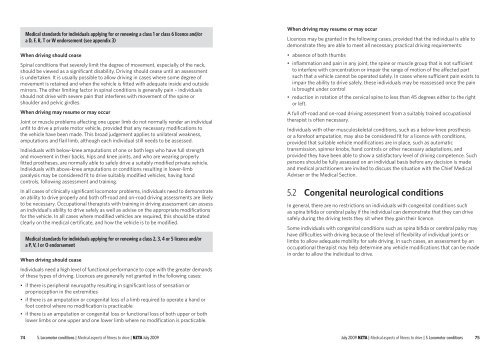Medical aspects of fitness to drive a guide for medical practitioners
Medical aspects of fitness to drive a guide for medical practitioners
Medical aspects of fitness to drive a guide for medical practitioners
You also want an ePaper? Increase the reach of your titles
YUMPU automatically turns print PDFs into web optimized ePapers that Google loves.
<strong>Medical</strong> standards <strong>for</strong> individuals applying <strong>for</strong> or renewing a class 1 or class 6 licence and/or<br />
a D, F, R, T or W endorsement (see appendix 3)<br />
When driving should cease<br />
Spinal conditions that severely limit the degree <strong>of</strong> movement, especially <strong>of</strong> the neck,<br />
should be viewed as a significant disability. Driving should cease until an assessment<br />
is undertaken. It is usually possible <strong>to</strong> allow driving in cases where some degree <strong>of</strong><br />
movement is retained and when the vehicle is fitted with adequate inside and outside<br />
mirrors. The other limiting fac<strong>to</strong>r in spinal conditions is generally pain – individuals<br />
should not <strong>drive</strong> with severe pain that interferes with movement <strong>of</strong> the spine or<br />
shoulder and pelvic girdles.<br />
When driving may resume or may occur<br />
Joint or muscle problems affecting one upper limb do not normally render an individual<br />
unfit <strong>to</strong> <strong>drive</strong> a private mo<strong>to</strong>r vehicle, provided that any necessary modifications <strong>to</strong><br />
the vehicle have been made. This broad judgement applies <strong>to</strong> unilateral weakness,<br />
amputations and flail limb, although each individual still needs <strong>to</strong> be assessed.<br />
Individuals with below‐knee amputations <strong>of</strong> one or both legs who have full strength<br />
and movement in their backs, hips and knee joints, and who are wearing properly<br />
fitted prostheses, are normally able <strong>to</strong> safely <strong>drive</strong> a suitably modified private vehicle.<br />
Individuals with above‐knee amputations or conditions resulting in lower‐limb<br />
paralysis may be considered fit <strong>to</strong> <strong>drive</strong> suitably modified vehicles, having hand<br />
controls, following assessment and training.<br />
In all cases <strong>of</strong> clinically significant locomo<strong>to</strong>r problems, individuals need <strong>to</strong> demonstrate<br />
an ability <strong>to</strong> <strong>drive</strong> properly and both <strong>of</strong>f‐road and on‐road driving assessments are likely<br />
<strong>to</strong> be necessary. Occupational therapists with training in driving assessment can assess<br />
an individual’s ability <strong>to</strong> <strong>drive</strong> safely as well as advise on the appropriate modifications<br />
<strong>for</strong> the vehicle. In all cases where modified vehicles are required, this should be stated<br />
clearly on the <strong>medical</strong> certificate, and how the vehicle is <strong>to</strong> be modified.<br />
<strong>Medical</strong> standards <strong>for</strong> individuals applying <strong>for</strong> or renewing a class 2, 3, 4 or 5 licence and/or<br />
a P, V, I or O endorsement<br />
When driving should cease<br />
Individuals need a high level <strong>of</strong> functional per<strong>for</strong>mance <strong>to</strong> cope with the greater demands<br />
<strong>of</strong> these types <strong>of</strong> driving. Licences are generally not granted in the following cases:<br />
• if there is peripheral neuropathy resulting in significant loss <strong>of</strong> sensation or<br />
proprioception in the extremities<br />
• if there is an amputation or congenital loss <strong>of</strong> a limb required <strong>to</strong> operate a hand or<br />
foot control where no modification is practicable<br />
• if there is an amputation or congenital loss or functional loss <strong>of</strong> both upper or both<br />
lower limbs or one upper and one lower limb where no modification is practicable.<br />
When driving may resume or may occur<br />
Licences may be granted in the following cases, provided that the individual is able <strong>to</strong><br />
demonstrate they are able <strong>to</strong> meet all necessary practical driving requirements:<br />
• absence <strong>of</strong> both thumbs<br />
• inflammation and pain in any joint, the spine or muscle group that is not sufficient<br />
<strong>to</strong> interfere with concentration or impair the range <strong>of</strong> motion <strong>of</strong> the affected part<br />
such that a vehicle cannot be operated safely. In cases where sufficient pain exists <strong>to</strong><br />
impair the ability <strong>to</strong> <strong>drive</strong> safely, these individuals may be reassessed once the pain<br />
is brought under control<br />
• reduction in rotation <strong>of</strong> the cervical spine <strong>to</strong> less than 45 degrees either <strong>to</strong> the right<br />
or left.<br />
A full <strong>of</strong>f‐road and on‐road driving assessment from a suitably trained occupational<br />
therapist is <strong>of</strong>ten necessary.<br />
Individuals with other musculoskeletal conditions, such as a below‐knee prosthesis<br />
or a <strong>for</strong>efoot amputation, may also be considered fit <strong>for</strong> a licence with conditions,<br />
provided that suitable vehicle modifications are in place, such as au<strong>to</strong>matic<br />
transmission, spinner knobs, hand controls or other necessary adaptations, and<br />
provided they have been able <strong>to</strong> show a satisfac<strong>to</strong>ry level <strong>of</strong> driving competence. Such<br />
persons should be fully assessed on an individual basis be<strong>for</strong>e any decision is made<br />
and <strong>medical</strong> <strong>practitioners</strong> are invited <strong>to</strong> discuss the situation with the Chief <strong>Medical</strong><br />
Adviser or the <strong>Medical</strong> Section.<br />
5.2<br />
Congenital neurological conditions<br />
In general, there are no restrictions on individuals with congenital conditions such<br />
as spina bifida or cerebral palsy if the individual can demonstrate that they can <strong>drive</strong><br />
safely during the driving tests they sit when they gain their licence.<br />
Some individuals with congenital conditions such as spina bifida or cerebral palsy may<br />
have difficulties with driving because <strong>of</strong> the level <strong>of</strong> flexibility <strong>of</strong> individual joints or<br />
limbs <strong>to</strong> allow adequate mobility <strong>for</strong> safe driving. In such cases, an assessment by an<br />
occupational therapist may help determine any vehicle modifications that can be made<br />
in order <strong>to</strong> allow the individual <strong>to</strong> <strong>drive</strong>.<br />
74 5. Locomo<strong>to</strong>r conditions | <strong>Medical</strong> <strong>aspects</strong> <strong>of</strong> <strong>fitness</strong> <strong>to</strong> <strong>drive</strong> | NZTA July 2009<br />
July 2009 NZTA | <strong>Medical</strong> <strong>aspects</strong> <strong>of</strong> <strong>fitness</strong> <strong>to</strong> <strong>drive</strong> | 5. Locomo<strong>to</strong>r conditions 75
















